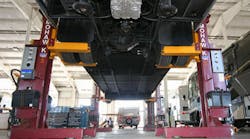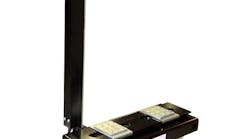Shop safety is an integral part of the productivity and efficiency of a repair and maintenance operation. That’s not to mention, adhering to best practices in shop safety helps to minimize the risk of personnel injury and damage to equipment. While numerous vehicle service equipment designs have been used for decades – such as in the case of traditional service jacks – manufacturers continue to look for ways to improve safety measures. Alec Stan, president of Stan Design Inc. discussed the challenges and safety concerns that technicians face in today’s shops when it comes to lifting vehicles, and what his company is working on to help address these concerns.
Transcription of interview:
Erica Schueller, Fleet Maintenance: Hi, and welcome to VSP News: Uptime Update. I am your host Erica Schueller, Editor-in-Chief of Fleet Maintenance magazine, covering all maintenance, all vehicle classes, all management, all the time.
Shop safety is an integral part of the productivity and efficiency of a repair and maintenance operation. That’s not to mention, adhering to best practices in shop safety helps to minimize the risk of personnel injury and damage to equipment. While numerous vehicle service equipment designs have been used for decades – such as in the case of traditional service jacks – manufacturers continue to look for ways to improve safety measures.
I talked with Alec Stan, president of Stan Design Inc., a Canadian-based heavy duty shop equipment manufacturer. Stan discussed the challenges and safety concerns that technicians face in today’s shops when it comes to lifting vehicles, and what his company is working on to help address these concerns.
First, we talked about the challenges technicians face today when lifting vehicles with traditional service jacks.
Alec Stan, Stan Design Inc.: The truck technician faces a lot of challenges. It’s a pretty hostile environment: there are the heavy vehicles to contend with, that are normally covered with some type of debris, salt, sand, dirt, rocks.
Consequently, the floor is covered with debris and the technician currently has to use conventional equipment to lift trucks, and that process is very time-consuming, and quite hard on a technician. He has to crawl across the floor several times to place hydraulic jacks, place stands to then support the truck, and to protect himself.
There’s a lot of up and down, back onto the ground, back up and down again for the technician. It can be quite tiring, and actually, very dangerous.
Schueller, Fleet Maintenance: Stan shares more details about some of the potential risks to consider when using a traditional service jack, and jack stands, to lift and support a heavy duty vehicle.
Stan, Stan Design: Currently in shops, the accepted practice is to lift the truck with either a bottle jack and two vehicle stands, or a 22-ton air jack and two vehicle stands. When you look at it, this seems like an okay way to lift the truck – relatively safe – but really, it’s not.
Fundamentally the first problem is, when you’re picking up the axle, the axle itself is a curved surface and the pickup point of the bottle jack is about 1-1/2” in diameter. When you put that bottle jack under the axle, there’s very little contact between the top of the bottle jack, and the axle.
When he starts to lift the truck, there’s a chance the truck can slip off that jack. That’s very dangerous.
Number two, when you get under the truck and you’re putting in the first stand, there’s really nothing protecting you accept the bottle jack. That’s a dangerous scenario. You put the stand in, and then you pull the bottle jack out. Go to the other side, lift that side, and again put the stand in. This whole process can take 10 to 15 minutes, which can be quite time-consuming, and inherently dangerous because the guy is under the truck the whole time. Accidents can happen, and they do all the time.
Schueller, Fleet Maintenance: Compared to a full vehicle lift, service jacks address a certain need for heavy duty repair. Stan talks about the most common reasons technicians choose to use a service jack in the shop.
Stan, Stan Design: Generally speaking, most truck repair is done off the floor. That’s why we designed the Scorpion TJ-12. The truck technician is working off of the floor most of the time and floor jacks are really the ideal way to repair trucks in that environment.
Also, truck components are quite heavy so it’s much easier to lift the truck component 3” to 5”, versus 5’ into the air. These are some of the limitations of a truck shop – the components are extremely heavy, and therefore the work is generally done off of the floor.
Schueller, Fleet Maintenance: Stan Design updated the existing service jack design with the introduction of the company’s Scorpion Jacks. The jacks feature a built-in lock assembly, which eliminates the need for vehicle stands.
Additionally, the equipment features two points of contact when lifting, among other features.
Stan discusses why these and other features, are important to improving vehicle lifting safety and technician productivity.
Stan, Stan Design: The technology and products available in the current marketplace are quite old designs, probably a century old.
We thought, "Let’s create something new, something safer, and something more productive for the shop," and we came up with the Scorpion TJ-12. The Scorpion TJ-12 floor jack lifts up across the front or rear axle, to stabilize the load, so there’s no chance of the truck slipping off of the jack.
As the jack goes up, there’s a three-stage safety lock that engages automatically for the technician, so the technician is always under safety. We also have a 9’ extendable handle, which allows the technician to adjust the jack so the jack will meet its pick-up point underneath the truck.
For instance, if the truck has a very deep overhang, you can simply extend the handle of the jack, and simply push the jack underneath the truck to the pick-up point of the truck – instead of crawling under the truck with your jack and picking up the truck that way.
It increases productivity, it increases safety, and increases throughput at the same time.
Schueller, Fleet Maintenance: Looking farther into the future, Stan shares some insights on where he believes the industry is headed when it comes to vehicle service.
Stan, Stan Design: The way we envision the future is a fully automated shop.
A technician will bring a truck into a shop, and either a jacking system will be built into the floor – which is automated with optical sensors. You’ll press a few controls and the jacks will position themselves in the appropriate spot underneath the truck.
Or, we would have robotic jacks that would deploy as the jack enters the shop and go underneath the truck to lift the truck automatically for the technician. Thus, eliminating any need for the technician to be under the truck and in harm’s way.
Schueller, Fleet Maintenance: If you’d like more information on best practices for using vehicle lifting equipment safely and effectively, check out the link below to access a recent feature story from Fleet Maintenance on this topic.
That’s all for this week! Thank you for tuning in to VSP News Uptime Update, I’m your host Erica Schueller.
Until our next broadcast, keep up with this, and other industry topics, by visiting us online at VehicleServicePros.com.
Learn more about safe vehicle lifting.

